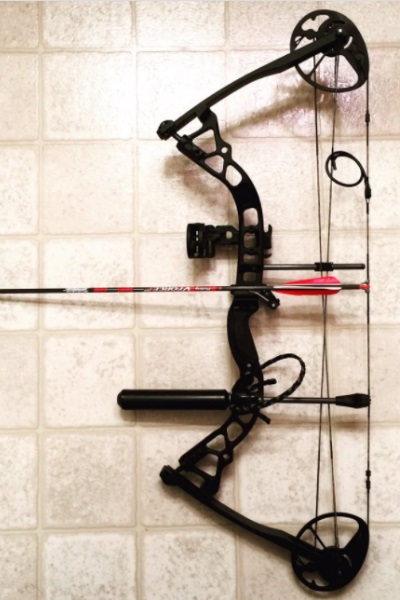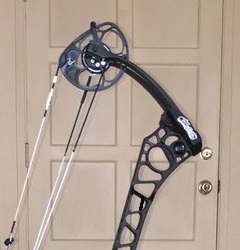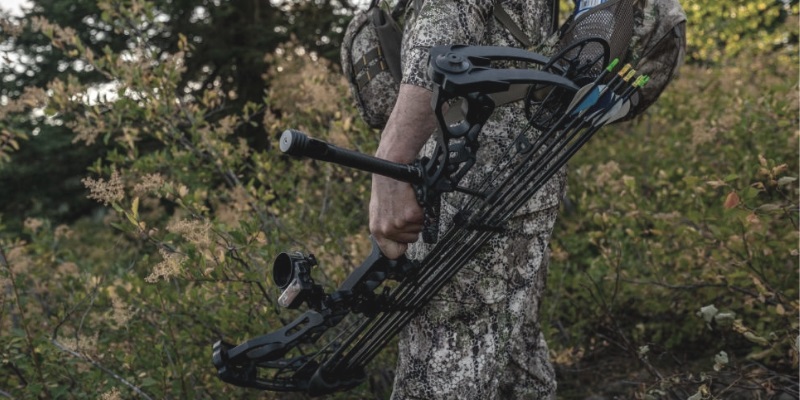Compound bow design has come a long way, transforming the way we approach hunting and target shooting. With advanced features, these bows have pushed the boundaries of performance, making them a popular choice among modern hunters—even surpassing traditional recurve bows for some. The unique blend of power, precision, and technology has caught the attention of a new generation of archers.
However, with the complexity of compound bows comes the challenge of finding the perfect fit for your needs. In this comprehensive guide, I’ll walk you through everything you need to know—from the key benefits and potential drawbacks to the essential features that define today’s top models. Whether prepping for a high-stakes bowhunting expedition or gearing up for a target shooting competition, this guide is packed with insights to help you choose the right bow for your next adventure.
What is a compound bow?
First, let’s define what a compound bow is. At its core, a bow is a weapon crafted from wood or other flexible materials, designed to launch arrows by harnessing tension through a flexible string. However, Compared to traditional bows, compound bows introduce a more advanced mechanism based on leverage. This system relies on two pulleys, or cams, placed at the ends of the bow’s limbs, which significantly reduces the physical effort needed to draw the bow.
The key advantage of a compound bow lies in its intricate design, which uses a combination of strings and metal pulleys to manage the bow’s limbs. This allows the archer to hold less draw weight at full draw, making it easier to aim and fire than with a traditional recurve bow. The result? Faster arrow speeds, increased precision, and more force on impact.
Because compound bows shoot arrows with a flatter trajectory, they offer better stability and accuracy, especially at longer distances, making them a favored choice for hunters looking to maximize power and precision in the field.
RELATED:
Advantages of using a compound bow
A compound bow offers numerous advantages over crossbows and recurve bows, largely due to its innovative design and constant technological advancements. Let’s explore this in detail:
The efficiency
A compound bow remarkably increases the effectiveness of the shooting. It has a cam system that makes it easier to tighten the rope while increasing the release force thanks to the pulleys. The pulleys help the archer to cock easily with minimal effort and tension to perform a powerful shot. This impact also increases efficiency and projection distance. So with little effort, you can pull the rope as much as you want, without disturbing the result of tension.
The balanced
Compound bows are equipped with an arrow rest which is great for balancing your arrow. They are also equipped with a release system to facilitate your shooting and offer a better shot on the target.
The stability
When a bow is drawn, the limbs are pulled inward by the tension of the string. In a traditional bow, such as a longbow, the limbs bend in proportion to the stiffness of the string. In contrast, compound bows feature limbs that are nearly parallel to each other when fully drawn. This parallel limb design minimizes recoil with each shot, as the forces generated move upward and downward along the bow, effectively canceling each other out. This results in greater stability and more accurate shooting.
The flexibility
Compound bows can be fitted with different types of cams to suit any situation. They are available in a wide range of designs, from soft to hard. The cam structure directly regulates the movement of the boom. What is called a “soft cam” will drive the boom slower than a hard cam.
Beginners typically choose a soft cam, while more seasoned archers often lean towards a harder cam to achieve optimal launch speed. Compound bow kits can be used by both experienced and beginner archers. They take little time to master and usually have sights to improve your shot and give you the most accuracy possible.
The precision
Precision is another advantage of the compound bow which increases the power of the shot, thanks to the cam systems. Famous brands sometimes come with a release that provides firmer grips and requires less effort to pull the string. Stability and precision are therefore guaranteed. Also, the bow sight allows for more precise shots.
Disadvantages
Compound bows are slightly heavier than other types of hunting bows, especially recurve bows. Most moving parts require additional maintenance and can be sources of larger points of failure. In the case of dry firing, the bow is more susceptible to damage because it allows more energy to be released. It requires the use of a mechanical release system. You can’t just use your fingers to tighten the rope.
Unlike recurve bows, adjusting or replacing strings on a compound bow requires a bow press—a specialized tool used to compress the limbs, loosen the strings, and relieve tension. Due to the complexity of this process, it often necessitates the expertise of a professional for repairs when a compound bow encounters issues.
Different types of compound bows
Compound bows can be categorized based on their cam system, with three main types: single cam, double cam, and hybrid cam. While pulleys are round and cams are oval, the cam system remains the key differentiator between models. Let’s explore each type in detail…
Single-cam compound bow
A single cam compound bow uses a single cam on the lower limb to store and release energy, while the upper limb is fitted with a freewheel. This simple design makes it easy to use and maintain. Some single cam bows are optimized for smooth shooting, while others prioritize speed. Although some models may encounter notch point alignment issues, they are known for their accuracy.
Double cam compound bow
In contrast to single-cam bows, double-cam bows offer greater power and speed but can experience timing issues. While these bows are generally easy to use and provide improved precision and performance, their ergonomics may vary depending on the brand and model.
Double-cam systems operate independently, which can lead to slight discrepancies in rotation due to rope friction, resulting in an imbalance between the upper and lower limbs and potentially causing notch displacement.
Hybrid cam pulley bow
Hybrid cams represent an advancement over dual cam systems by addressing timing issues. They feature two asymmetrical elliptical cams, with the control cam positioned above the power cam. This setup includes a divided harness, control cord, and tensioning mechanism. Although the hybrid cams operate independently, they require occasional adjustments to maintain optimal performance.
Many hybrid cam bows deliver exceptional speed and quiet operation. Although the pull cam is aligned, the cams do not necessarily maintain alignment relative to each other. However, a hybrid cam pulley bow offers incredible speed and precision, similar to dual cam compound bows, with the advantage of synchronized cam operation for enhanced accuracy.
How to choose the best compound bow?

Selecting the right compound bow can be challenging, particularly in a market flooded with hundreds of new models each year. However, by evaluating key characteristics, you can identify a model that fits your needs and budget. Let’s outline the essential criteria you should consider to ensure you choose the best compound bow for your requirements.
Purpose of use
There are several reasons to buy a compound bow. Some people use it in the context of a sport, others simply as a hobby, and some use this equipment to hunt games. However, each use requires different functionalities. If you are a hunter, you need equipment that allows you to shoot long distances with maximum power. On the other hand, if you want to use your bow for target shooting, you don’t necessarily need an overpowered model. Instead, you can choose a bow that allows you to shoot accurately. For example, a heavier bow will help you get a more accurate shot, which is not recommended for hunting.
Overall Length
The ideal bow length varies based on your needs, body type, and size. Generally, the draw length influences the overall bow length, which can differ depending on your intended use. If you’re a hunter, opting for a shorter bow will facilitate easier carrying and maneuverability in the field. Conversely, for target shooting, a longer bow can enhance stability and accuracy.
Limbs
The bow limbs store the energy generated when the shooter pulls back the bowstring. These limbs are attached to the riser and the cams (more on that in a bit) and come in various styles. Normally compound bow limbs are constructed with composite laminated material which can consist of wood, fiberglass, and carbon. Solid glass limbs are also available.
Split limbs are popular for target shooting practice. These are made up of two thin limbs connected at the riser. Split limbs are also more durable and produce less vibration and quieter bows than the solid variety. On the other hand, parallel limbs are found on most hunting compound bows. Most hunting bows have parallel limbs.
Your extension
This is an important criterion that should not be overlooked when buying a compound bow. The draw is the distance the rope will travel before it stops when you pull it. If you choose a long model, you may lose some of the power. On the contrary, if your draw is too short, you will not be well-positioned to use your bow properly. It can even affect your level of precision.
There are several ways to calculate your draw, but you can easily determine it by extending your arms parallel to the ground and measuring the distance between the tips of your fingers.
Then refer to this table:
| Span | Extension (in inches) |
| 145 to 150 cm | 22 to 23 |
| 151 to 158 cm | 23 to 24 |
| 159 to 165 cm | 24 to 25 |
| 166 to 173 cm | 25 to 26 |
| 174 to 182 cm | 26 to 27 |
| 182 to 188 cm | 27 to 28 |
| 189 to 196 cm | 28 to 29 |
| 196 cm and more | more 30 |
Weight
The weight of the bow can affect the way you shoot. The lighter the bow, the easier it is to carry with you. A heavier bow may be easier to use if you are target shooting. This criterion is questionable and is more of a personal position, so find something that works for you. But be aware that the higher the weight, the more difficult it is to shoot for some. But the shot will be all the more powerful.
Speed
Calculated in FPS, the speed of a compound bow is another important metric that can sometimes convince you to look for an accurate model. Speed is an indicator of the strength of your bow. Of course, it is also influenced by the weight of the arrow. The higher the speed, the stronger the bow.
You may not need a high-speed compound bow if you are only aiming at targets.
Precision
While speed is undoubtedly crucial in archery, it’s essential to recognize that it isn’t the sole determining factor. Despite the widespread appeal of powerful bows with impressive FPS coverage for shooting arrows at high speeds, remember that high speed alone is ineffective if you miss your target. Precision holds equal importance in achieving successful outcomes.
Ergonomics
This is another feature to consider when purchasing your compound bow. Make sure that you can easily stand up and hold the bow firmly to deliver consistent and powerful shots. A compound bow that offers a good grip allows you to shoot accurate shots repeatedly. This requires you to be able to hold yourself correctly to adopt the correct posture and hold the bow in a relaxed and balanced manner.
Bow sight
Consider the presence and quality of the sight (included in the package or not) before choosing a compound bow. This allows you to determine the height you need to hold your bow to fire accurate shots depending on the distance you need. Sights vary in their functionality and specification, ranging from floating single pins to 7-pin configurations, each performs in different ways with different accuracy.
Type of cams
You already know that compound bows are essentially available in 3 different types (see earlier in the article). As a reminder, the three main types of bow available are the single cam, double cam, and hybrid cam. Each type has its own strengths and weaknesses.

For example, the single-cam bow is simple to use and quiet, but the speed is not very high. The double-cam compound bow is difficult to adjust but offers incredible arrow speed. The hybrid cam bow provides ease of maintenance and adjustment.
Dominant eye
Even if you have the best bow release in the world, you still need to figure out how to shoot with your dominant eye. This can be the right eye or the left eye. Once you understand this, you must consider a compound bow that matches your dominant eye.
The adjustment
This is another thing to consider if you are looking for the best compound bow for the first time. If you are an adult archer, you probably don’t need a lot of adjustment for your bow. But if you are still young and a growing hunter, you can choose one with flexible fit options both in length and size.
RELATED:
The price
This is always something archers take into account when looking to purchase a compound bow. Bows can be made from different materials and can have various qualities. Those of better quality and better design will logically be more expensive. However, there are still compound bows with good value for money that might be suitable for you. Don’t break the bank on buying a good bow. You can always save for the compound bow of your dreams and get a cheaper one to practice while you wait.
Conclusion
Now you have considerable knowledge about the compound bow. Keep in mind that each model offers its own settings: arrow speed, grain, band, and the weight of the bow or let-off. To avoid bad ergonomics, look at whether the model is right-handed or left-handed. Also, don’t forget to check the power of the bow.
Thanks for reading!
Have any questions? Ask in the comment section below and I will answer it.
Frequently Asked Questions
What is the significance of the bow’s let-off percentage?
The let-off is the reduction in draw weight at full draw, allowing the archer to hold less weight. This feature enhances accuracy and reduces fatigue. Different bows offer varying let-off percentages, so choose one that suits your preferences and shooting style.
What accessories do I need for a compound bow?
Essential accessories include arrows, a sight, a stabilizer, a rest, and a release aid. Additional items like a bow case, quiver, and wrist sling can enhance your overall archery experience.
What safety measures should I follow when using a compound bow?
Always adhere to proper archery safety guidelines. This includes checking equipment regularly, using appropriate arrows, ensuring a proper backstop for target shooting, and following ethical hunting practices if using the bow for hunting purposes.
Can I tune and customize my compound bow?
Absolutely. Compound bows are highly customizable. From adjusting draw length and draw weight to adding accessories like sights, stabilizers, and arrow rests, archers can fine-tune their bows to fit their specific preferences and shooting needs.
Can I upgrade my compound bow over time?
Yes, many components of a compound bow can be upgraded or replaced as your skills and preferences evolve. This flexibility allows archers to enhance their equipment without investing in an entirely new bow.
What maintenance does a compound bow require, and how often?
Regular maintenance involves checking and waxing the strings, inspecting cables and cams for wear, and ensuring that all screws and bolts are properly tightened. Performing these checks every few weeks, or after intense use, helps prolong the bow’s lifespan.
